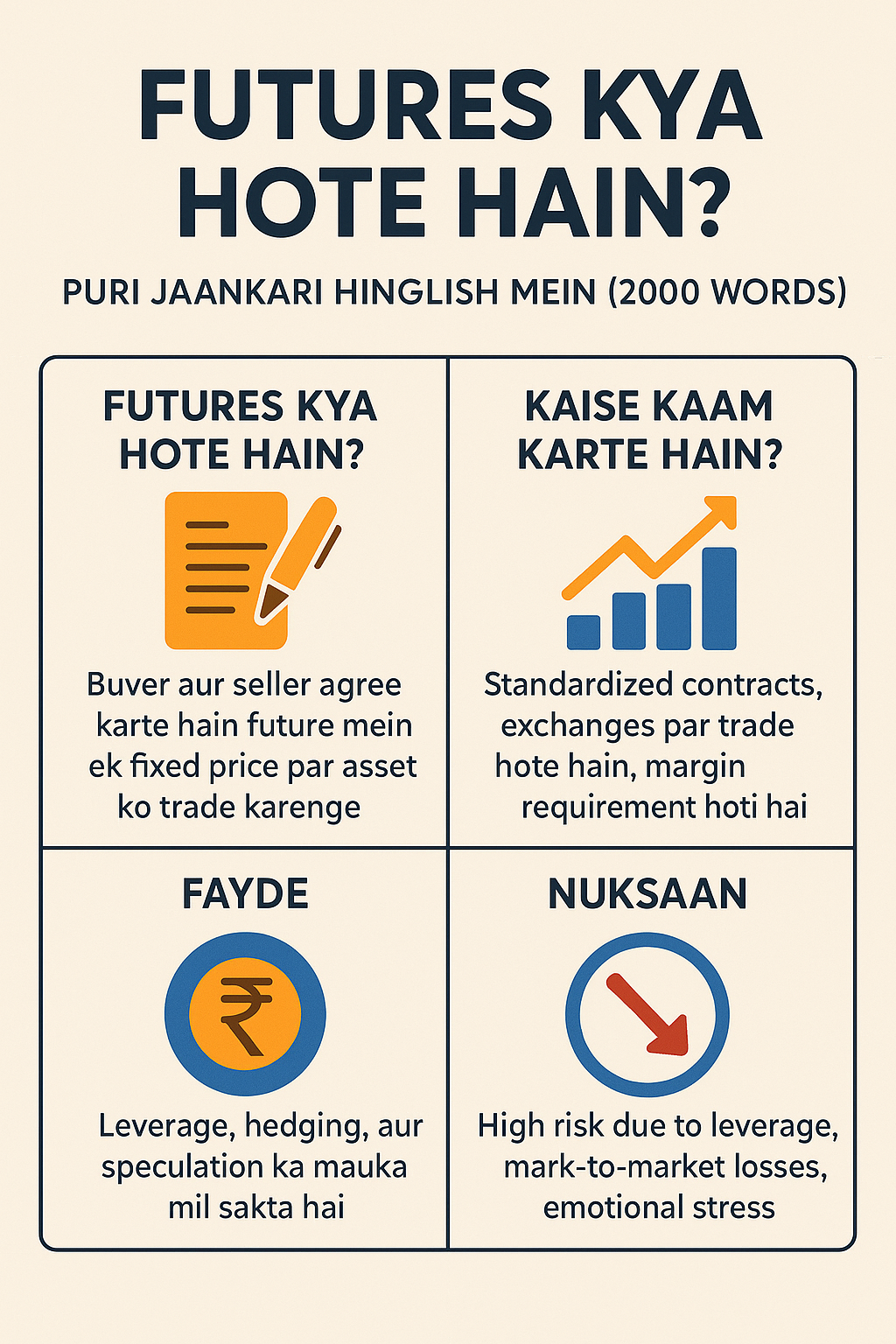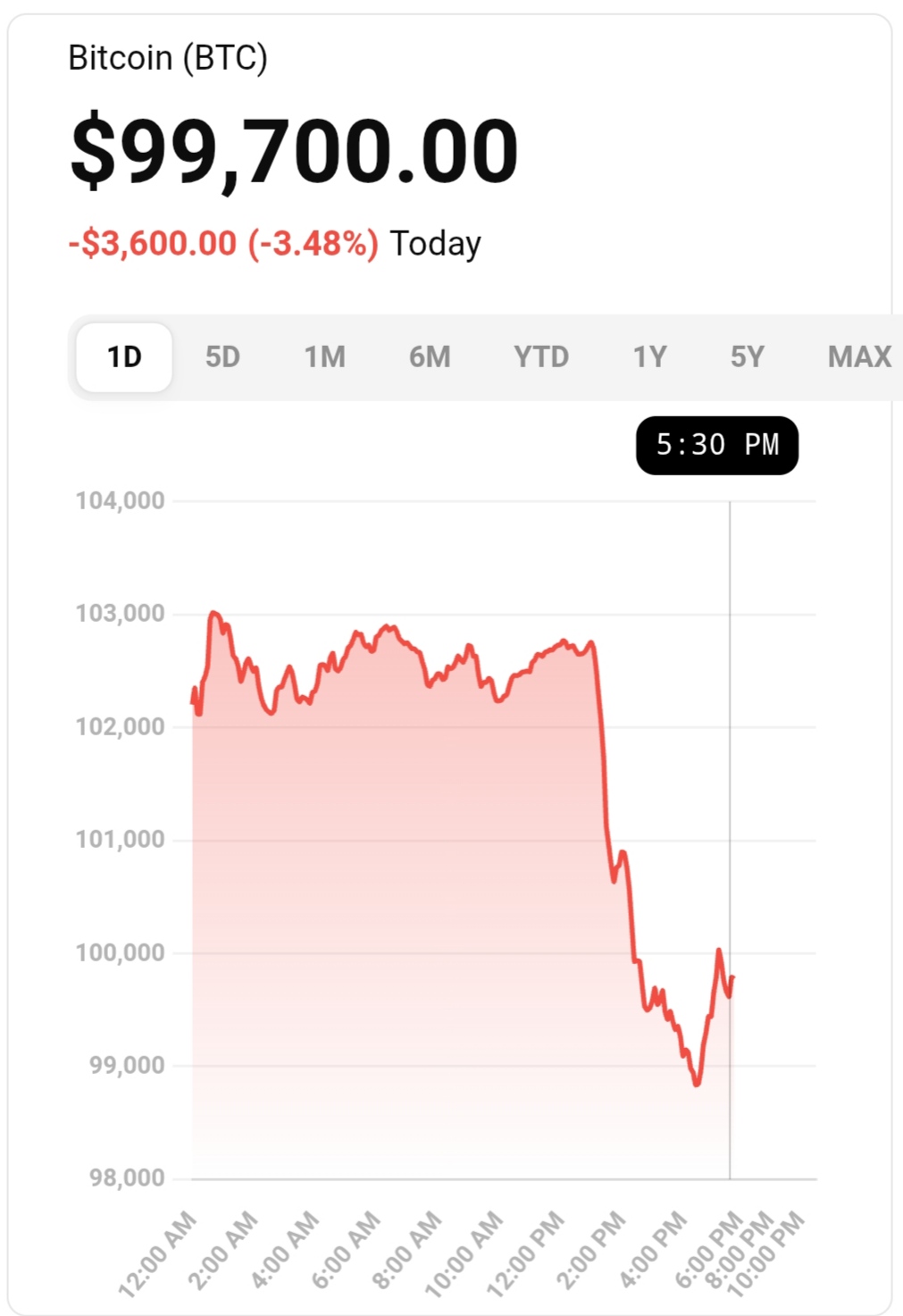What are Futures?
Introduction: Basic meaning of Futures.
If you are interested in stock market, commodities, or finance, then you must have heard the name of “futures” or “futures trading”. But many people are confused as to what it is? Futures is a financial contract in which buyer and seller agree to buy or sell an asset in future at a fixed price.In this article, we will explain step-by-step:
What are futures?
How do they work?
Why are they used?
What are the risks?
And how can you earn money (or lose money) from futures trading.
1. Futures Contracts: A Simple Definition Futures are a legal agreement in which both parties (buyer and seller) agree to trade an asset at a certain price on a certain date. These contracts are settled on an organised exchange such as NSE (National Stock Exchange) or BSE, and are standardised.
Example: Suppose you think the price of crude oil will rise next month. You buy a futures contract in which you agree to buy 1 barrel of oil for ₹7000 after a month. If the actual price rises to ₹8000, you will make a profit of ₹1000.
2. What is the difference between Futures and Forwards?
Many people confuse futures and forwards. Both seem similar but there are some basic differences between them:
Feature Futures Forwards. Trading Exchange-based (OTC) Platform.
Standardization Standardized Customisable . contract
Settlement Mark-to-market End of contract
Regulation Highly regulated. Less regulated
3. What are Futures for?
Futures contracts are available for a wide range of assets:
1 Stock Futures (e.g. Reliance, TCS)
2 Index Futures (e.g. Nifty, Bank Nifty)
3 Commodity Futures (e.g. Gold, Silver, Crude Oil)
4 Currency Futures (e.g. USD/INR, EUR/INR)
5 Interest Rate Futures
This means that you can trade futures not only on stocks but also on commodities and currencies.
4. How does a Futures Contract work?
4.1 Lot Size and Expiry Futures contracts are in fixed lot sizes. For example, if you want to buy a futures contract of Reliance, its lot size can be 250 shares. This means that you will have to take exposure to 250 shares for 1 contract.
Every futures contract has an expiry date – generally the last Thursday of every month. You can hold it till expiry or square it off before that.
4.2 Margin Requirement In futures you do not have to pay the entire money. You only have to pay a margin amount which is around 10-20% of the total contract value. This is leverage which can lead to huge profit as well as loss.
5. Benefits of Futures Trading
5.1 Leverage You can get more exposure by investing less money. This can make a big profit even in small movements.
5.2 Hedging Tool If you already have a stock and you want to avoid its falling price, then futures can become a good hedge.
Example:You have 500 shares of Infosys and you feel that the price may fall in the short-term. You sell Infosys futures. If the stock falls, your loss can be recovered from futures.
5.3 Opportunity for Speculation If you have the skill to understand the direction of the market, then you can speculate and make profit. Futures can be quite rewarding for active traders.
6. Disadvantages of Futures Trading
6.1 High Risk due to Leverage Leverage means high profit as well as high risk. If the market goes against you, you can lose your entire capital.
6.2 Mark-to-Market Losses There is a daily settlement, which is called mark-to-market. In this, the daily profit or loss is reflected in the account. If there is a big loss, you can also get a margin call.
6.3 Complexity and Emotional Stress Trading in futures is quite technical and it is difficult to control emotions. A new trader can quickly get into panic and take the wrong decision.
7. How to Start Futures Trading?
Step 1: Open Trading Account You have to open Demat + Trading account with a broker that has futures trading enabled. Popular brokers are: Zerodha, Angel One, Upstox, Groww etc.
Step 2: Provide Margin After opening the account, you have to deposit margin amount as per the rules of your broker.
Step 3: Select Contract Select the contract of the stock, index, or commodity you want to trade. Check lot size, expiry and current premium.
Step 4: Place the order You can place a buy or sell order, depending on your analysis. Set the stop loss and target levels in advance.
8. Real-Life Example: Profit and Loss from Futures
Profit Example: Suppose you bought Nifty Futures at 22,000 for 1 lot (lot size 50).
Nifty fell to 22,300
Profit = (22,300 – 22,000) * 50 = ₹15,000
Loss Example:
If Nifty fell to 21,800
Loss = (22,000 – 21,800) * 50 = ₹10,000
If you had given a margin of ₹20,000, then 50% of your capital was gone in a single day.
9. Best Strategies for Futures
9.1 Trend Following Strategy You can identify the trend of the market and trade using technical analysis tools like moving averages, RSI, MACD.
9.2 Breakout Strategy When a stock or index breaks its resistance, you can buy futures.
9.3 Spread Trading In this, you simultaneously buy one futures contract and sell another – generally on different expiry or commodity. This reduces the risk.
10. Futures Trading Tips for Beginners
Start with paper trading: Practice in virtual trading first.
Use stop loss: Never trade without a stop loss.
Pay attention to news and events: Follow the economic calendar.
Avoid overleveraging: Always trade according to your capital.
Learning Continuously: Trading is a skill, it takes time to learn.
11. Future of Futures Market in India The futures market in India has matured a lot. Exchanges like NSE and MCX see turnover of crores of rupees every day. Retail participation is also increasing.T
he government and SEBI (Securities and Exchange Board of India) are bringing new rules which will increase transparency and safety.
Conclusion: Is Futures Trading Right for You?Futures is a powerful financial instrument that gives you the opportunity to earn profit. But it is equally risky. If you work with discipline, learn risk management, and know how to analyze the market, then futures trading can be beneficial for you.But if you are impulsive and trade without planning, you may have to bear losses. Therefore, always invest real money only after learning and practicing.
Disclaimer: This article is for educational and informational purposes only. The views, examples and strategies presented here are for general understanding and are not intended to be investment advice of any kind. Futures trading involves high risk, with a chance of capital loss.
It is important to consult your financial advisor or a SEBI-registered expert before investing. The author and publisher will not be responsible for any financial loss that may occur as a result of following the information in this article.
Invest in the market at your own risk.







Post Comment